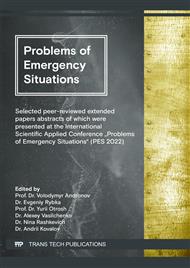p.69
p.77
p.87
p.105
p.115
p.125
p.131
p.138
p.143
Application of Coating for Fire Protection of Textile Structures
Abstract:
The results of experimental research on the effectiveness of fire protection of easily erected structures made of flammable textile products are presented. Analysis of the use of structures made of flammable textile products, which are easy to build, shows a steady trend to increase their use during the temporary implementation of certain tasks of the Armed Forces of Ukraine and SES units. During the heating of such buildings, fires and rapid spread of fire are possible. Statistics on the operation of easily erected structures have shown a low level of safety due to the use of natural fibers (such as flax, cotton and mixtures), which are highly sensitive to high temperatures and fire. After the test, it is seen that the raw sample of textile material supports self-combustion for more than 5 s, the damage to the sample is more than 200 mm. After testing the flame retardant sample, it is seen that the sample of textile material does not support self-combustion; damage to the sample not more than 40 mm. Inhibition of the process of ignition and spread of flame for such a sample is associated with the decomposition of flame retardants under the action of temperature with heat absorption and release of non-combustible gases (nitrogen, carbon dioxide), changing the direction of decomposition towards non-combustible gases and flame retardant coke. This leads to an increase in the thickness of the coke layer and inhibition of heat transfer of high temperature flame to the material, which indicates the possibility of transition of textile materials when treated with a flame retardant composition to materials related to non-combustible surfaces that do not spread flame.
Info:
Periodical:
Pages:
115-121
Citation:
Online since:
July 2022
Authors:
Price:
Сopyright:
© 2022 Trans Tech Publications Ltd. All Rights Reserved
Share:
Citation:



